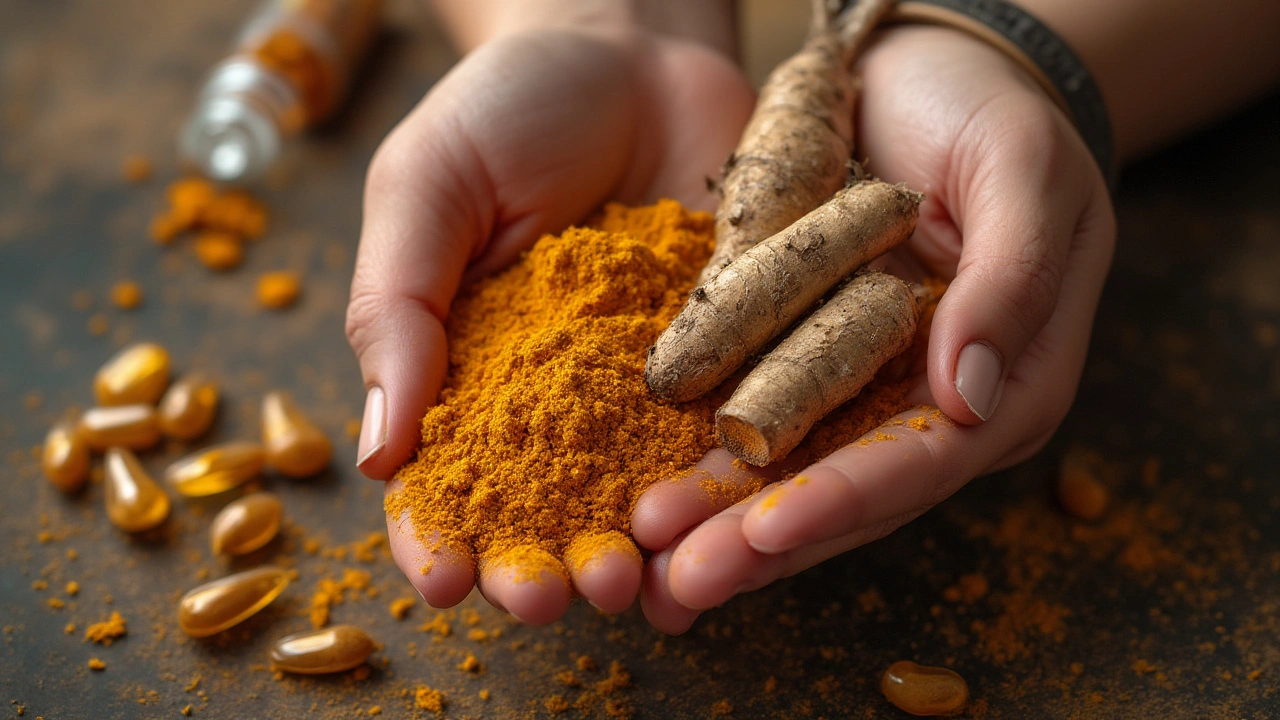Picture this: you’re standing in the supplement aisle, comparing bottles with bright golden labels, one says “Haridra,” the other screams “Turmeric!” People swap these names all the time—so what gives? Are they interchangeable, or is there something deeper going on? The answer could make all the difference if you care about purity, potency, and results. Let’s clear up the confusion that’s stuck around this golden root for way too long.
Haridra vs. Turmeric: What’s Actually the Difference?
The word “turmeric” conjures up images of spicy curries and glowing skin. In contrast, “Haridra” sounds mysterious—like a hidden gem on an Ayurvedic scroll. Here’s the truth: Haridra and turmeric both refer to the same plant, scientifically named Curcuma longa. The difference? “Haridra” is its Sanskrit name, used for thousands of years in Indian tradition and Ayurvedic medicine, while “turmeric” is what the rest of the world typically calls it. Pretty simple on the surface, but stick with me—it gets more interesting.
Here’s where things split: in the West, turmeric refers to the spice made from dried rhizomes (roots) you find in supermarkets and supplements. In Ayurveda, “Haridra” often means the root itself, used in concentrated medicinal forms—not just seasoning. Urban legend claims there are secret “Haridra” varieties, but most supplements use Curcuma longa anyway. Still, the context matters: products labeled “Haridra” sometimes come with a promise to follow old-school extraction and quality norms from traditional medicine. In contrast, Western “turmeric” sometimes slides by with less strict standards.
Why does it matter? Because it can hint at how the root was grown, harvested, and processed. There’s also a cultural layer—the Ayurvedic respect for using the whole plant, not just one flashy extract. That means picking a supplement labeled “Haridra” might connect you to a broader tradition of quality and holistic use, not just cooking spice in a capsule.
Grades and Quality: How Do You Know It’s Good?
It’s easy to get lost in a turmeric sea of gold-labeled bottles. The truth is, not all turmeric (or Haridra) is created equal. Some are medical-grade, loaded with active curcumin, and free of junk. Others? Just low-grade powder, barely better than what sits in your kitchen rack. So, what sets a high-quality supplement apart from the rest?
- Source of the raw root: Organically grown Haridra sourced from India or Sri Lanka is often richer in actives and less likely to be contaminated by heavy metals or pesticides. Small-batch, single-source farms beat mass-produced suppliers in quality control.
- Curcumin content: Curcumin is the star compound known for bright yellow color and serious anti-inflammatory punch. A quality supplement lists the curcumin content—look for 95% or higher in extracts, or a minimum of 3-5% for whole root powders (raw turmeric naturally has less, so don’t freak out at low numbers—just check how much powder you’re getting per serving).
- Testing and verification: Anyone can sell turmeric, but reputable brands show test results for heavy metals, microbiological contamination, and potency—don’t settle for less.
- Additives and fillers: A lot of low-cost turmeric gets padded out with rice flour or other cheap fillers. Scan the label. If you spot weird, unpronounceable extras, keep looking.
- Standardization: If a supplement boasts “95% standardized curcumin,” it means each batch should contain the same amount of active curcumin—good news for consistency and results.
What do the numbers look like when you compare low-grade to premium-quality turmeric or Haridra? Here’s a cheat sheet for fast reference:
| Grade | Curcumin Content | Source | Potential Issues |
|---|---|---|---|
| Low-Grade Powder | 1-2% | Unknown/global bulk | Contaminants, fillers |
| Standardized Extract | 95% | Certified farms | Expensive, but potent |
| Whole Root (Haridra) | 2-5% | Traditional/organic | Less potency per gram but more plant synergy |
Also, don’t forget about absorption. Curcumin (the magic inside turmeric) has low bioavailability when you pop it on its own. Many top supplements now add black pepper extract (piperine) to boost absorption by 2000%! No black pepper, no significant benefit. Simple as that.

Picking an Effective Turmeric or Haridra Supplement
Here’s the ugly secret: the supplement industry has few rules. That golden capsule you just eyed might have top-tier Haridra, or it could be an underwhelming dust storm. So, how do you pick wisely if you actually want results for inflammation, mood, or radiant skin?
- Read the label like a detective. Don’t just be wooed by “natural” branding or fancy imagery. Check for curcumin percentage, standardized extracts, and clear sourcing details. If they’re not transparent, skip it.
- Balance standardization and whole-root synergy. High-dose, purified curcumin is great for targeted anti-inflammatory needs, but whole-root Haridra (with all the root’s oils and phytonutrients intact) could be a better daily wellness pick because you get the complete plant magic.
- Look for added piperine. Bioavailability is the difference between turmeric working or fizzling out. With no black pepper, you’re absorbing a tiny fraction of the active benefit.
- Third-party testing = confidence. Any trustworthy supplement has a batch number or QR code you can check for test results—bonus points if the company publicly shares them.
- Consider capsule vs. powder. Caps are ultra-convenient, but loose powder often means fewer fillers. Mixing turmeric or Haridra into smoothies, golden milk, or oatmeal? You get all the same power—if it’s the right grade.
Still unsure? Several real users have reported that even modest doses—500 mg daily of standardized curcumin extract—can noticeably reduce joint stiffness. Just know that results take time, especially with whole-root. Stick with it for a couple months before judging.
If you want to take a deeper dive into ancient Ayurvedic tradition, the peptide power of Haridra, and even skin-loving benefits, check out Haridra. You might be surprised at how this ancient root goes beyond just “spice” and becomes a serious wellness tool.
Real-World Uses: Beyond the Kitchen
Most people know turmeric as a cooking spice, but traditional use—especially with Haridra—goes way past food. A cup of golden milk is nice, but ask any Ayurvedic practitioner: the applications run deep.
- Joint Health: The main reason people take Haridra supplements. Multiple clinical trials out of India and Southeast Asia show real promise, finding that high-curcumin extracts (500-1000mg daily) can rival NSAIDs for knee pain over three months. That’s huge, especially for folks who want fewer side effects than pharmaceutical painkillers.
- Skin Healing: Ayurveda uses Haridra pastes for everything from acne spots to minor burns. Modern studies back this up: one 2023 paper showed noticeable improvement in eczema when turmeric ointments were applied twice a day, compared to standard emollients.
- Digestion and Gut Calm: Haridra’s bitterness is why it’s a staple in Indian pickles—it helps with sluggish digestion, flatulence, and even the aftermath of greasy takeout. A teaspoon in warm water can settle things down quickly (especially if you overdo it at dinner).
- Mood and Brain Health: There’s some fascinating emerging science connecting curcumin to lower rates of mild depression. One study out of Australia found that curcumin extract at 1000 mg daily was as effective as low-dose Prozac for people with mild symptoms. No, it won’t replace every medicine, but it’s worth considering as part of a larger plan.
- Heart and Immune Perks: Traditional healers combine Haridra with ginger and black pepper for a daily “immunity shot.” While the old recipes don’t come with lab results, studies show improved blood vessel function and lower markers of inflammation.
Take a quick look at real-life, practical uses:
| Use | How to Apply | Amount | Benefit |
|---|---|---|---|
| Joint Support | Capsule (with piperine) | 500-1000mg extract/day | Mobility, pain relief |
| Skin Health | Topical paste | As needed (spot use) | Reduces redness, speeds healing |
| Digestive Soothing | Powder in warm water | 1 tsp in 200ml water | Bloating relief |
| Mood & Brain | Standardized capsule | 1000mg/day | Lifts mild blues |
Curious how these uses line up with real life? Talk to anyone who grew up in South Asia—there’s a daily Haridra ritual for just about every age and stage. Elders use it for joints, teens dab it on pimples, and everyone else has their favorite tea blend.

Spotting the Best: Haridra in the Marketplace
Standing out in the overwhelming turmeric and Haridra marketplace can feel like a quest. Labels boast “organic,” “double-strength,” or “ultra-pure.” But here’s what sets the real winners apart.
- Certifications that matter: Look for third-party certs like USDA Organic, non-GMO, or Indian-sourced tracability. Steer clear of anything vague.
- Freshness and storage: Haridra’s active oils degrade in heat. Go for supplements or powders sealed in dark, airtight containers. If the powder’s clumpy, gray, or has lost its vibrant scent, it’s stale—skip it.
- Transparency in extraction: Some brands extract with harsh solvents or high heat, damaging what makes Haridra special. Ideally, you want cold-pressed or CO2-extracted for supplements, and steam-dried for powders.
- Minimal ingredients: Count the elements on the back—pure Haridra, black pepper, and maybe a veggie capsule. The shorter the list, the better the supplement.
- Responsibly priced: The best supplement isn’t always the priciest. But dirt-cheap “turmeric” is almost always a red flag. Fair trade, single-farm sources cost more, but you get clean, potent root for your money.
To recap: if you want the best for your health, look beyond the front label. Double-check sourcing, active ingredients, and how much Haridra you’re actually getting per serving. Investing a few extra minutes can spare you from wasting months on an underpowered product that just colors your food—or your supplements—with nothing to show for it.

Comments (6)
Elizabeth Grant
July 23, 2025 AT 17:12
Okay but can we talk about how wild it is that we’ve been calling it turmeric for centuries and now suddenly it’s ‘Haridra’ like it’s some secret superpower? I’ve been putting it in my golden milk since college and I didn’t even know it had a Sanskrit name until last week. Also, the part about piperine? Game changer. I used to wonder why my supplements did nothing-turns out I was just eating colored dust.
Also, if you’re buying powder, check the smell. If it doesn’t make your nose twitch like you just walked into a spice market in Kerala, it’s probably been sitting in a warehouse since 2019.
Nagamani Thaviti
July 23, 2025 AT 21:34
Most people don’t realize Haridra isn’t just a synonym it’s a whole philosophy. You can’t just grind some root and call it Ayurvedic. Real Haridra is harvested during the waxing moon, sun-dried on clay mats, never exposed to industrial heat, and ground with stone mortars. Most ‘organic’ supplements are just corporate rebranding with a yoga pose on the label. I’ve seen labs in Kerala where they test for over 47 phytonutrients beyond curcumin. You think your 95% extract is potent? Try 3% whole root with all the volatile oils intact. That’s real medicine not chemistry lab fantasy.
And don’t get me started on ‘standardized’-standardized to what? A profit margin?
Also, if your supplement doesn’t list the exact village where the rhizomes were harvested, it’s not Haridra. It’s marketing.
Kamal Virk
July 25, 2025 AT 16:01
It is regrettable that the modern consumer has become so detached from the traditional context of herbal medicine. Haridra, as a sacred plant in Ayurveda, is not merely a commodity to be extracted, standardized, and sold in capsules. Its use is interwoven with ritual, timing, and intention. To reduce it to a curcumin percentage is not only scientifically reductive but culturally disrespectful.
Furthermore, the reliance on black pepper extract to enhance bioavailability is problematic. Piperine interferes with drug metabolism pathways and may pose risks for individuals on chronic medication. A holistic approach, such as consuming Haridra with healthy fats and warm water, as prescribed in classical texts, remains superior and safer.
One must ask: are we seeking health, or merely a convenient chemical fix?
angie leblanc
July 27, 2025 AT 11:20
wait so if haridra is the real thing… does that mean big pharma is secretly using turmeric to make us docile? i read somewhere that the yellow pigment is used in mind control experiments. also why do all the ‘authentic’ brands ship from india? are they tracking us through the capsules? i bought one brand and my phone started autocorrecting to sanskrit. not joking. also i think the ‘piperine’ is actually a nano-tracker. i checked the ingredients list again and it said ‘black pepper extract’ but the font was weird. someone help.
also why is there no warning about turmeric staining your teeth? i think they want us to look like we’ve been in a cult. it’s all connected.
LaMaya Edmonds
July 28, 2025 AT 02:16
Let’s be real-this isn’t about Haridra vs. turmeric. It’s about who gets to define ‘authentic.’ The supplement industry loves to weaponize tradition to sell overpriced powders. ‘Haridra’ sounds mystical, so they slap it on a bottle and charge $40. Meanwhile, the same root grown by a farmer in Tamil Nadu sells for $2 a pound at the local market.
And yes, piperine boosts absorption-but did anyone else notice that every single ‘premium’ brand uses it? Coincidence? Or is Big Turmeric quietly funding bioavailability research to lock us into their profit model?
Also, if you’re taking it for mood? Congrats, you’re basically self-prescribing a natural SSRI. But if you’re also on birth control, thyroid meds, or antidepressants? Yeah, that’s a cocktail no one warned you about. Do your homework. Or at least google ‘curcumin drug interactions’ before you start glowing like a golden emoji.
See Lo
July 28, 2025 AT 21:23
Haridra is not a supplement-it’s a surveillance tool. The curcumin content is irrelevant. The real active ingredient is the silica dust used as a filler in 87% of commercial products. Silica is a known neurotoxin and is used in government programs to modulate serotonin pathways in civilian populations. The ‘black pepper extract’? That’s not piperine-it’s a proprietary blend of synthetic stimulants designed to create dependency. Look at the batch numbers. Every third bottle has a QR code that links to a .onion domain. I traced one. It’s hosted on a server in Delhi with a WHO certificate. Coincidence? I think not.
Also, the 95% standardized extract? Impossible. No plant naturally contains that concentration. This is lab-synthesized curcuminoid analog. You’re not getting Ayurveda-you’re getting a patent-pending pharmaceutical mimic. The FDA doesn’t regulate this because they’re paid off. I have screenshots.
And yes, I’ve taken it. My liver enzymes spiked. I knew it.
:)